- Published on
Google CTF Quals 2019 writeups
- Authors

- Name
- Furkan Er
Table of contents
I've been eagerly waiting for this year's Google CTF because last year I couldn't even solve one challenge. I tormented my soul for three days straight trying to solve the infamous 'keygenme'(I was so close). Entering this CTF I wanted to be able to see at least one flag, and I'm happy to say that I did. It ain't much, but it's honest work.
(sandbox) DevMaster 8000

We're given a binary builder platform for cloud that is slightly sandboxed. There are prebuilt binaries to connect and use the platform. Upon spawning a shell and checking uid and gids, I noticed that my sandbox is still in the root group:

This opens up possibilities, especially if we have suid binaries lying around. With a stroke of luck, I found the perfect binary drop_privs under /home/user that allows me to execute commands as any user:

The flag is CTF{two-individually-secure-sandboxes-may-together-be-insecure}
(re) Dialtone

Decompiling with GHIDRA, I saw pulseaudio functions being used. The program starts recording to buffer, then processes buffer into buffer2 in function x, finally does some checks on buffer2 in function r and checks the return value.
undefined8 main(undefined8 uParm1,undefined8 *puParm2)
{
int iVar1;
long paObj;
undefined8 uVar2;
uint *puVar3;
char *pcVar4;
undefined1 *puVar5;
undefined buffer [32768];
undefined buffer2 [131076];
undefined4 local_24;
undefined4 local_20;
undefined local_1c;
uint local_18;
int ret;
puVar5 = ss.3811;
pcVar4 = "record";
paObj = pa_simple_new(0,*puParm2,2,0,"record",ss.3811,0,0,&local_18);
if (paObj == 0) {
uVar2 = pa_strerror((ulong)local_18);
fprintf(stderr,"pa_simple_new() failed: %s\n",uVar2);
uVar2 = 1;
}
else {
local_24 = 0;
local_20 = 0;
local_1c = 0;
do {
puVar3 = &local_18;
iVar1 = pa_simple_read(paObj,buffer,0x8000);
if (iVar1 < 0) {
uVar2 = pa_strerror((ulong)local_18);
fprintf(stderr,"pa_simple_read() failed: %s\n",uVar2);
return 1;
}
x(buffer,buffer2,buffer2);
ret = r(&local_24,buffer2,(int)buffer2,(char *)puVar3,(int)pcVar4,(int)puVar5);
if (ret < 0) {
fwrite("FAILED\n",1,7,stderr);
return 1;
}
} while (ret != 0);
fwrite("SUCCESS\n",1,8,stderr);
pa_simple_free(paObj);
uVar2 = 0;
}
return uVar2;
}
Function x was too complicated for me, so I tried to analyze r first. At this point I was thinking that the binary could be analyzing the frequencies of the recordings, and the first thing that came to my mind was DTMF tones. After checking the tone frequencies:

and seeing the exact numbers in the function r, it clicked. The code must be a sequence of DTMF dials. With this assumption, I decompiled and renamed the whole function:
void r(void *dialTone,void *buffer)
{
bool bVar1;
double lowFreq [4];
double highFreq [5];
int yCoord;
double maxFreq2;
int yCoordFinal;
uint xCoord;
double maxFreq;
uint xCoordFinal;
*(int *)dialTone = *(int *)dialTone + 1;
if (*(int *)dialTone < 0x15) {
highFreq[0] = (double)f(buffer,0x4b9);
highFreq[1] = (double)f(buffer,0x538);
highFreq[2] = (double)f(buffer,0x5c5);
highFreq[3] = (double)f(buffer,0x661);
xCoordFinal = 0xffffffff;
maxFreq = 1.00000000;
xCoord = 0;
while ((int)xCoord < 4) {
if (maxFreq < highFreq[(long)(int)xCoord]) {
xCoordFinal = xCoord;
maxFreq = highFreq[(long)(int)xCoord];
}
xCoord = xCoord + 1;
}
lowFreq[0] = (double)f(buffer,0x2b9);
lowFreq[1] = (double)f(buffer,0x302);
lowFreq[2] = (double)f(buffer,0x354);
f(buffer,0x3ad);
yCoordFinal = -1;
maxFreq2 = 1.00000000;
yCoord = 0;
while (yCoord < 4) {
if (maxFreq2 < lowFreq[(long)yCoord]) {
yCoordFinal = yCoord;
maxFreq2 = lowFreq[(long)yCoord];
}
yCoord = yCoord + 1;
}
if (*(char *)((long)dialTone + 8) == '\0') {
if ((-1 < (int)xCoordFinal) && (-1 < yCoordFinal)) {
xCoordFinal = yCoordFinal << 2 | xCoordFinal;
bVar1 = false;
switch(*(undefined4 *)((long)dialTone + 4)) {
case 0:
bVar1 = xCoordFinal == 9;
break;
case 1:
bVar1 = xCoordFinal == 5;
break;
case 2:
bVar1 = xCoordFinal == 10;
break;
case 3:
bVar1 = xCoordFinal == 6;
break;
case 4:
bVar1 = xCoordFinal == 9;
break;
case 5:
bVar1 = xCoordFinal == 8;
break;
case 6:
bVar1 = xCoordFinal == 1;
break;
case 7:
bVar1 = xCoordFinal == 0xd;
break;
case 8:
if (xCoordFinal == 0) {
return;
}
}
if (bVar1) {
*(int *)((long)dialTone + 4) = *(int *)((long)dialTone + 4) + 1;
*(undefined4 *)dialTone = 0;
*(undefined *)((long)dialTone + 8) = 1;
}
}
}
else {
if (((int)xCoordFinal < 0) && (yCoordFinal < 0)) {
*(undefined *)((long)dialTone + 8) = 0;
*(undefined4 *)dialTone = 0;
}
}
}
return;
}
Extracting the sequence from the switch-case statement:
tones = [1,2,3,'A',4,5,6,'B',7,8,9,'C','*',0,'#','D']
for i in [9,5,10,6,9,8,1,0xd,0]:
print(tones[i], end='')
859687201
The flag is CTF{859687201}